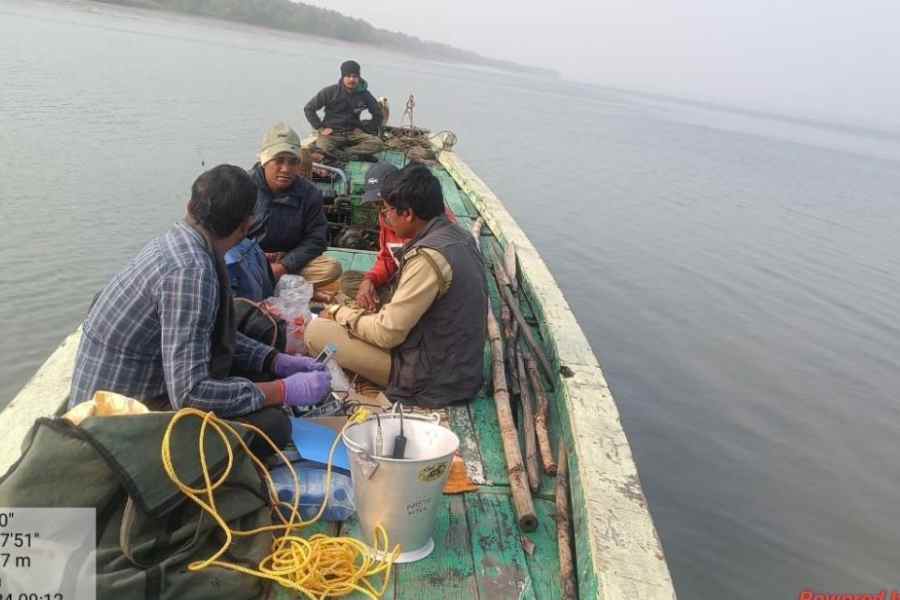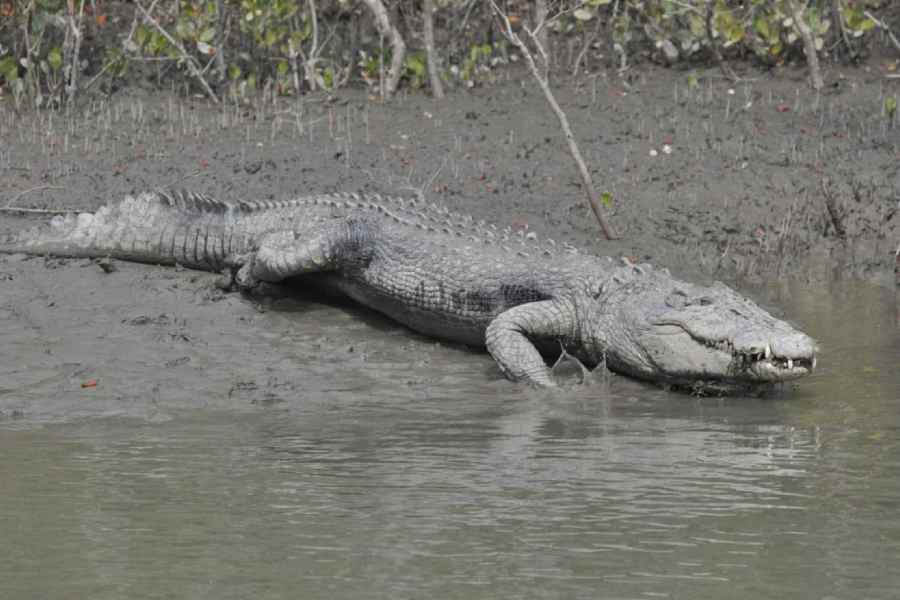An exercise is under way in the Sunderbans to estimate the population of the delta’s top predator.
Not the tiger, which sits on top of the food chain on land, but the estuarine crocodile (Crocodylus porosus) — the largest living reptile in the world — which lords over the brackish waters.
The exercise is taking place after 12 years. The last one in 2012 had estimated around 140 crocodiles, a forest official said.
On four days last month, small teams on boats scanned around 900km of riverbanks and creeks for physical sightings.
“We had 22 teams, out of which 14 were deployed for the Sunderbans Tiger Reserve and eight for the South 24-Parganas forest division. Each team had forest department personnel as well as representatives of local wildlife NGOs,” said Nilanjan Mallick, director of the Sundarban Biosphere Reserve.
The Sajnekhali and Basirhat ranges of the STR and the Matla range of the South 24-Parganas division were covered on January 17 and 20.
The National Park East and National Park West of the STR and the Raidighi and Ramganga ranges of the South 24-Parganas division were covered on January 20 and 21.
Overcast conditions stalled the survey on January 18 and 19.
“Each boat covered 40km in two days. The data, compiled on the basis of the physical sightings and the health of the habitat, is being prepared now. A preliminary report is expected on February 6 and a final report as soon as possible,” Mallick said.

One of the 22 teams counting the crocodiles. Picture courtesy: The Sunderban Biosphere Reserve
Unlike the tiger census, where images captured by cameras are fed into a software that uses statistical tools to estimate the population, the crocodile population estimate is done on the basis of physical sightings and sign surveys, and the assessment of the habitat.
Winter is the ideal time for a survey of crocodiles because that is when they are mostly spotted while basking in the sun on the banks of rivers and creeks.
“The tidal calendar is key to any such exercise. The days when the tide is at its lowest is ideal for physical surveys,” said B.C. Choudhury, a former scientist at the Wildlife Institute of India and member of the crocodile specialist group in the International Union for Conservation of Nature (IUCN), who provided the technical expertise for the population estimate.
Choudhury conducted a training camp for the team members.
The entire area (around 900km) that was scanned has been divided into “large, small and medium” habitats, he said.
“Based on the physical sightings, we will come to a basic index of the number of crocodiles per kilometre in each habitat. That data will be extrapolated to the larger Sunderbans habitat (which is spread over 4,000sqkm in the Indian side). The actual sightings across 900km should be around 60 per cent of the total population,” said Choudhury.
“This is an assessment of the population trend, not a drive to get the exact number,” he said.
There is little chance of a crocodile being counted twice because like tigers, crocodiles are also very territorial, he added.
The estuarine crocodile is found in eastern India, Southeast Asia and northern Australia. There have been instances of males growing up to 20 feet and weighing over 1,000kg.
“In the Sunderbans, the average length of an estuarine crocodile is around 12ft. Locals and our men have in the past seen a male grow up to 15ft,” said a forest official.
“Apart from their size, their high tolerance for salinity separates saltwater crocodiles from their cousins like gharials, muggers and caimans. Storms and high tides push them into the sea. They can survive the rise in the salinity. But their ideal habitat is brackish water,” he said.
Debal Roy, chief wildlife warden of Bengal, said: “Like the tiger, the crocodile is also a Schedule I animal. A tiger is the top predator in the terrestrial ecosystem. The estuarine crocodile is the top predator in the aquatic ecosystem. The assessment of the crocodile population is a study of the entire aquatic ecosystem.”
Saltwater crocodiles are known to have the greatest bite force among living animals. Their bite is nearly four times stronger than that of a tiger or a lion and, according to an international study in 2012, might rival that of the mighty Tyrannosaurus rex.
In 2011, a tiger was killed by a crocodile at Dobanki camp of the Sunderbans Tiger Reserve.











